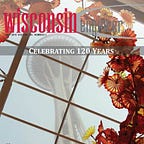Hamel Music Center: The Intersection of Engineering and Music
By: Mary Laudon
One of the busiest intersections in Madison is now home to the most musical building on campus. The Hamel Music Center opened its doors this fall after a two-year construction period and a tremendous fundraising effort. Behind the glass doors lie three halls, each skillfully designed to provide students and faculty with state-of-the-art performance spaces.
The Mead Witter Foundation Concert Hall and Collins Recital Hall replace the use of Mills and Morphy Halls in the Mosse Humanities Building. Previously, when recordings were taken for students to submit to graduate school or ensembles, the HVAC system was so loud it had to be turned off. “A hall really is another musical instrument — it’s part of the ensemble,” says facilities director Brian Heller. Students’ performances will no longer be inhibited by the restrictions of the Humanities Building. Instead, the new hall will enhance the ensemble by serving as a cohesive part of the performance.
Both the concert hall and recital hall feature motorized, retractable curtains to allow for the adjustment of sound in the room. Reverberation of sound can be changed by using one of twelve programmable settings, tailored specifically to the wants and needs of the ensemble. The programming was done by acoustician Rick Talaske of Talaske Group Inc., an acoustic and sound consulting company from Chicago. Talaske created an accurate prediction of how the space would sound even before construction began. Talaske has a computer model that accounts for the shape, materials, and angles of the space to measure the reflections from the stage and absorption of the seats. No model is perfect, though. In early September, students were encouraged to come and listen to performances so the model could be put to the test and final adjustments could be made.
“This is the most complicated building JP Cullen has done… They’ll never do another building like it.” -Susan Cook
In addition to the motorized curtains, the large concert hall features two reverberation chambers on each side of the stage, 30 feet in the air. These “ears,” as they are called, allow for acoustic energy from sound produced on the stage to enter the room, bounce off hard surfaces, and be redirected back into the room. There are no parallel surfaces in these chambers in order to prevent standing sound waves, therefore allowing for almost all the acoustic energy to be redirected and allowing for a high reverberation time. Reverberation time describes the rate of sound decay — the time it takes for sound to die away after the sound source ends. Higher reverberation time allows for increased control of sound in a space, making it a critical component in the overall acoustics.. For reference, the average reverberation time of Carnegie Hall in New York is 1.7 seconds, Symphony Hall in Boston is 1.8 seconds and Musikvereinsaal in Vienna is 2.05 seconds [1]. With a maximum reverberation time of around 2.3 seconds, the Mead Witter Foundation Concert Hall is right on par with some of the best performing spaces in the world.
An imperative aspect of the design of the building was ensuring that the mechanical systems were isolated to prevent the intrusion of their sound. Each music hall is surrounded by two concrete walls separated by a two-inch air gap, called an acoustic joint. This air gap isolates the space from vibrations conducted by hard surfaces in the building. In addition, mechanical systems and plumbing are led through back corridors and pipes are wrapped with added insulation. In the concert hall and recital hall, air is slowly diffused through gaps in the floor underneath the seats. This allows for the quietest flow of air possible, while maintaining heating and cooling requirements of the building.
Throughout the building, design and acoustics are intertwined in almost every way. The construction of the entire space was completely based on the acoustics; each material was evaluated for its acoustical properties. Many structures serve a dual purpose as both a design element and aiding the acoustics of the space. The circular panels in the walls of the concert hall absorb and reflect sound back into the hall, but also give the space character. The exterior of the building is pleasing to the eye while providing soundproofing in the form of 16-inch-thick double walls.
The Hamel Music Center was designed and constructed by a team of professionals and companies from around the country, while also featuring many local Wisconsin companies. A familiar face on the project was Ben Sonnentag, a 2016 UW-Madison graduate and UW Engineer. A civil engineering major, Sonnentag was the project’s site engineer for contractor JP Cullen and provided valuable input as a former UW-Madison jazz band musician. “This is the most complicated building JP Cullen has done … They’ll never do another building like it,” says Susan Cook, Director of Mead Witter School of Music.
The construction of Hamel Music Center has proven the importance of teamwork and interdisciplinary teams. This performance center, the product of the integration of engineering and the arts, highlights the musical abilities of our campus and provides opportunities that will resonate throughout the state of Wisconsin.
[1] “21- Design of Studios and Listening Rooms.” Architectural Acoustics, by Marshall Long, 2nd ed., Elsevier Academic Press, 2014, pp. 829–871.
